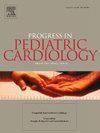Consequences and complications of un-intervened congenital heart defects in children: A retrospective cross-sectional study
IF 0.8
Q4 PEDIATRICS
引用次数: 0
Abstract
Background
Children with unrepaired congenital heart defects (CHDs) are at risk of developing complications related to the scarcity of interventions, delayed diagnosis, financial constraints, and difficulty reaching facilities in low-and middle-income countries.
Objective
Describe the frequency of complications by age and CHD type in children with un-intervened CHDs seen at Bahir Dar University Tibebe-Ghion Specialized Teaching Hospital.
Method
We conducted a retrospective cross-sectional study on children with un-intervened CHDs seen from September 01, 2021, to August 31, 2024. Data were collected from September 20 to 30, 2024, retrospectively. Categorical variables were analyzed in the form of proportions. Discrete variables were summarized as means (SD). Binary logistic regression was performed with 95 % confidence interval. P-value <0.05 was considered significant. Data were analyzed using SPSS version 27.
Result
Of the 310 children with un-intervened CHDs, 47 % were female. The mean (SD) age was 28 months (42). Wasting (46 %) is the most common complication in children with CHD, followed by congestive heart failure (41 %), and recurrent respiratory tract infection (30 %). Seventy percent of children with un-intervened CHDs have at least one complication (68 % of acyanotic and 77 % of cyanotic CHDs). After adjusting for covariates, one month increase in age of children with un-intervened CHD increases the proportion of complications by 2 % {AOR = 1.019, 95 % CI = (1.007, 1.031)}.
Conclusion
A higher proportion of children with CHD had at least one or more complications. A one month delay in intervention of children with un-intervened CHDs has a 2 % increase in the occurrence of complications.
未经干预的儿童先天性心脏缺陷的后果和并发症:一项回顾性横断面研究
背景:在低收入和中等收入国家,患有先天性心脏缺陷(CHDs)的儿童面临并发症的风险,这些并发症与干预措施缺乏、诊断延误、财政限制以及难以到达医疗机构有关。目的分析巴希尔达尔大学附属教学医院非介入性冠心病患儿的并发症发生率,按年龄和冠心病类型进行分类。方法对2021年9月1日至2024年8月31日期间未干预的CHDs患儿进行回顾性横断面研究。资料于2024年9月20日至30日回顾性收集。分类变量以比例的形式进行分析。离散变量汇总为均值(SD)。采用二元logistic回归,置信区间为95%。p值<;0.05被认为是显著的。数据分析采用SPSS 27版。结果310例未干预的冠心病患儿中,女性占47%。平均(SD)年龄为28个月(42)。消瘦(46%)是CHD患儿最常见的并发症,其次是充血性心力衰竭(41%)和反复呼吸道感染(30%)。70%的非介入性冠心病患儿至少有一种并发症(68%为无紫型冠心病,77%为紫绀型冠心病)。调整协变量后,未干预冠心病患儿年龄增加1个月并发症比例增加2% {AOR = 1.019, 95% CI =(1.007, 1.031)}。结论冠心病患儿至少有一种或多种并发症的比例较高。对未干预的冠心病患儿延迟干预1个月,并发症发生率增加2%。
本文章由计算机程序翻译,如有差异,请以英文原文为准。
求助全文
约1分钟内获得全文
求助全文
来源期刊

PROGRESS IN PEDIATRIC CARDIOLOGY
PEDIATRICS-
CiteScore
0.90
自引率
11.10%
发文量
69
审稿时长
75 days
期刊介绍:
Progress in Pediatric Cardiology is an international journal of review presenting information and experienced opinion of importance in the understanding and management of cardiovascular diseases in children. Each issue is prepared by one or more Guest Editors and reviews a single subject, allowing for comprehensive presentations of complex, multifaceted or rapidly changing topics of clinical and investigative interest.
 求助内容:
求助内容: 应助结果提醒方式:
应助结果提醒方式:


